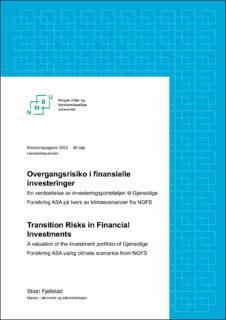| dc.contributor.advisor | Fretheim, Torun | |
| dc.contributor.author | Fjellstad, Stian | |
| dc.coverage.spatial | Norway | en_US |
| dc.date.accessioned | 2021-09-21T13:37:47Z | |
| dc.date.available | 2021-09-21T13:37:47Z | |
| dc.date.issued | 2021 | |
| dc.identifier.uri | https://hdl.handle.net/11250/2779931 | |
| dc.description.abstract | Parisavtalen introduserte målet om å begrense global oppvarming til godt under 2 °C, og helst til 1,5 °C. Global oppvarming er knyttet til klimagassutslipp, som igjen er knyttet til økonomisk aktivitet. Å begrense global oppvarming krever store endringer i hvordan verdier skapes, og i Parisavtalen er det vedtatt at majoriteten av endringene skal gjennomføres innen 2050. Formålet med denne oppgaven er å undersøke om finansielle investeringer påvirkes av overgangsrisiko, og om overgangsrisikoen kan bli en finansiell risiko.
Forskere har lenge brukt klimamodeller for å modellere økonomiske konsekvenser av klimaendringer. Disse krever ulike sett av forutsetninger, som samles i scenarioer. I denne oppgaven sammenstilles framskrivninger fra scenarioer publisert av NGFS med Merton-modellen. Formålet er å modellere konsekvenser av overgangsrisiko for Gjensidige Forsikring ASAs investeringsportefølje. Porteføljen verdsettes i en ovenfra-og-ned analyse av klimapolitisk relevante sektorer. Sektorenes utvikling i overgangsscenarioet relativt til nåsituasjonen samles i en sjokkfaktor som brukes til å verdsette porteføljeselskapene. Differansen i markedsverdi mellom scenarioene som representerer nåsituasjonen og overgangsscenarioet presenteres som et estimat på overgangsrisiko.
Resultatene viser at overgangen til et lavutslippssamfunn kan medføre betydelige verdiendringer for finansielle investeringer. Investeringer i sektorer med høye klimagassutslipp påvirkes negativt av overgangen. Den negative endringen kan reduseres og snus til en positiv verdiendring med ustrakt bruk av karbonfangstteknologi. Sektorer som er substitutter for høyutslippssektorer påvirkes i alle scenarioer positivt av overgangen til et lavutslippssamfunn. Det vises også at overgangsrisikoen er høyere i scenarioer som begrenser global oppvarming til 1,5 °C enn sammenlignbare scenarioer som begrenser global oppvarming til 2 °C, samt at valg av scenario som beskriver nåsituasjonen er svært viktig for resultatet. Valg av modell er viktig, ettersom like klimascenarioer kan gi forskjellige resultater som følge forskjeller i modellenes oppbygning og forutsetninger. Dersom bare scenarioene som overholder krav satt av Miljødirektoratet analyseres, vises det at estimert overgangsrisiko er negativ i alle scenariokombinasjoner, at økt karbonfangst reduserer estimert overgangsrisiko og at et strengere utslippsmål gir en høyere estimert overgangsrisiko. | en_US |
| dc.description.abstract | The Paris Agreement introduced a common global goal of limiting global warming to well below 2 °C and preferably to 1,5 °C. Global warming is linked to emissions of greenhouse gases, which is further linked to economic activity. Limiting global warming will demand immense changes to how value is generated. The Paris Agreement states that the transition must happen by 2050. The purpose of the analysis is to examine whether financial investments are affected by transition risks, and whether the transition risks can evolve into financial risks.
Scientists use Integrated Assessment Models (IAM) to model economic consequences of climate change. The models require sets of prerequisites, that are brought together in climate scenarios. This analysis uses climate scenarios published by NGFS as inputs into the Merton model. The purpose is to model financial consequences of transition risks on the investment portfolio of Gjensidige Forsikring ASA. The portfolio is valued in a top-down analysis of a set of climate policy relevant sectors, where the development of each sector in the transition scenarios relative to Business-as-Usual is gathered in a shock factor that is used to value the portfolio companies. The difference in market value between BaU and the transition scenarios is presented as an estimate of the transition risk in the portfolio.
The results show that the transition to a low-carbon economy may cause considerable changes to the value of the financial portfolios. Investments in high-emitting sectors are negatively affected by the transition, although the negative effects can be reduced, and change to positive effects with high usage of carbon dioxide removal. Investments in sectors that are substitutes to high-emitting sectors are valued higher in all transition scenarios. It is also shown that transition risks in scenarios that limit global warming to below 1.5 °C are lower than in comparable scenarios that limit global warming to below 2 °C, and that the choice of BaU-scenarios are important for the results. The choice of IAM is also important, as differences in model structure and prerequisites may give different developments in equal scenarios. If only scenarios that complies with requirements set by the Norwegian Environmental Agency are analyzed, it is shown that the estimated transition risk is negative in all scenario combinations, that carbon dioxide removal reduces transition risks and that a stricter emission cap increases transitions risks. The transition risk can however never turn positive in these scenarios. | en_US |
| dc.language.iso | nob | en_US |
| dc.publisher | Norwegian University of Life Sciences, Ås | en_US |
| dc.rights | Attribution-NonCommercial-NoDerivatives 4.0 Internasjonal | * |
| dc.rights.uri | http://creativecommons.org/licenses/by-nc-nd/4.0/deed.no | * |
| dc.title | Overgangsrisiko i finansielle investeringer : en verdsettelse av investeringsporteføljen til Gjensidige Forsikring ASA på tvers av klimascenarioer fra NGFS | en_US |
| dc.title.alternative | Transition Risks in Financial Investments : a valuation of the investment portfolio of Gjensidige Forsikring ASA using climate scenarios from NGFS | en_US |
| dc.type | Master thesis | en_US |
| dc.description.localcode | M-ØA | en_US |

